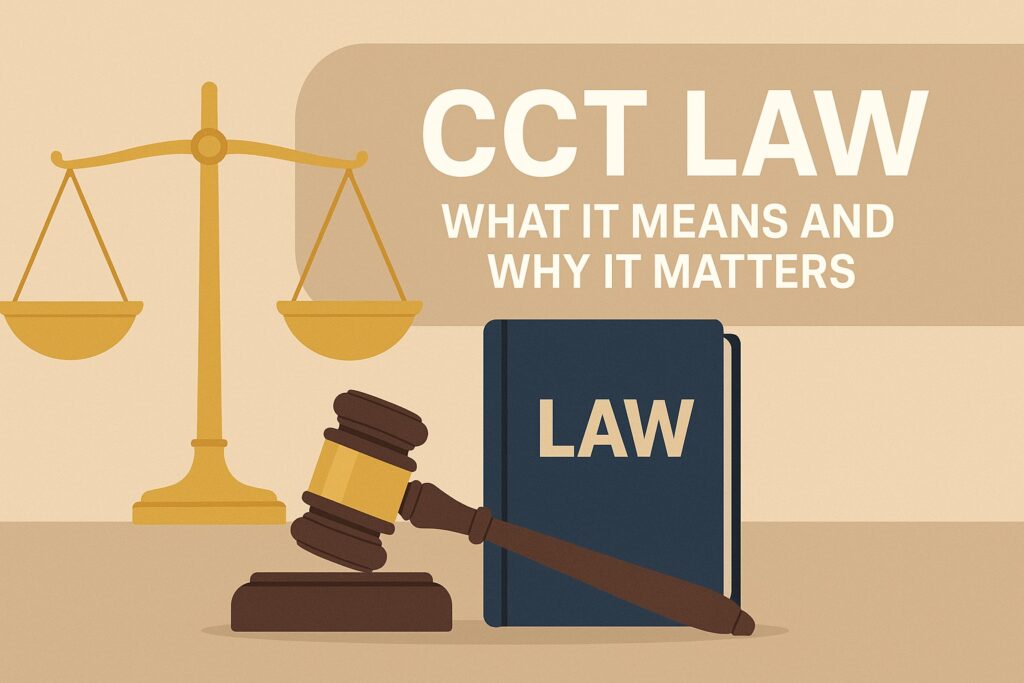Laws control how people, businesses, and governments act. Each law serves a goal. Some protect health. Some protect rights. Others make sure public money is used fairly. One rule that changed this space is called CCT law.
CCT means Compulsory Competitive Tendering. It forced local councils to let private companies bid on public services. Before this, councils gave jobs to their own teams without open bids. Supporters believed CCT helped save money. Critics said it harmed quality and put workers at risk.
This law did more than change old habits. It shaped how modern governments hire help. It set rules that still guide contract deals today. People in law, policy, and public work still study what it did.
This article explains what CCT law means, where it started, how it worked, and what impact it left. It also shows why the public should care about how services get picked and paid for.
What Is CCT Law?
CCT law forced local governments to offer public service contracts through open bidding. This meant private firms could compete with council-run departments. Every bid had to follow the same terms and rules.
Before this law, councils handled tasks like cleaning, waste removal, and building repairs on their own. They gave the work to in-house teams without review. CCT law changed that. It made councils prove they offered the best value. If a private firm had a better offer, it often won the job.
The goal was to remove bias. The law aimed to lower costs, improve services, and bring new ideas into public work. It pushed councils to act more like private businesses.
Why Did CCT Law Start?
CCT law began during a time of change. Many leaders wanted smaller governments. They said the public sector spent too much and lacked strong results. They trusted private firms to work faster and cheaper.
In the UK, CCT became law in the 1980s. It matched a wider push to reduce government control. Leaders believed free markets could fix problems that public bodies could not solve.
CCT was not just a budget rule. It was a shift in thinking. It showed that even services like trash pickup or street cleaning could become part of a business-style model. This shift soon reached schools, transport, and other sectors.
How Did It Work?
Councils had to list services open to bids. They wrote job details, set budgets, and gave firms a chance to apply. In-house teams also joined the bidding process but had to follow the same rules.
Firms sent their offers. The council picked the one that met the terms and cost the least. The winner got a contract to complete the work. Some contracts lasted one year. Others lasted five or more.
Each bid had clear goals. Payment came only after results. Firms had to follow deadlines, safety rules, and quality checks. Any failure led to warnings or contract cuts.
Pros of CCT Law
Supporters saw many wins. The law often lowered spending. Councils had to rethink their budgets. Many cut waste or trimmed staff. This saved taxpayer money.
CCT also forced better planning. Councils had to write full contracts, not hand out jobs with no records. This made work clearer and more open.
Private firms brought new tools and ideas. Some used machines or software to speed up work. This raised quality in many places. Public teams had to match these gains or risk losing the work.
Problems and Criticism
Not all saw CCT as a success. Many said it hurt service quality. Some firms underbid just to win jobs. Once hired, they cut staff or skipped key tasks. This led to poor results and public anger.
Worker rights also took a hit. Council staff lost jobs or faced lower pay. Many firms hired new teams with fewer benefits. Morale dropped in city departments.
CCT focused too much on price. It often ignored long-term value. A cheap offer looked good on paper. But poor work cost more in repairs, delays, and public complaints.
End of CCT and What Came After
In time, leaders saw flaws in the system. CCT was replaced with new rules, such as Best Value. These rules still allowed bidding but gave weight to quality, fairness, and long-term plans.
Best Value aimed to balance cost with care. It asked councils to think beyond price. It also gave workers more voice and helped protect service standards.
Yet, many ideas from CCT stayed. Open bidding is still the norm in public jobs. Private firms still compete with public teams. The process remains part of modern law.
Why CCT Law Still Matters Today
CCT law changed how people think about public work. It taught lessons about money, trust, and control. It showed that rules must balance savings with service.
Governments today still use bids to hire workers. Many debates ask the same old questions. Should price beat quality? Can private firms serve the public well? How do we protect staff without blocking new ideas?
People in law, politics, and business still study CCT. It offers insight into reform, risk, and reward. Its history helps shape how we write and follow rules today.
Conclusion
CCT law forced change. It made councils prove their value and face open bids. It brought savings, but it also caused stress. It gave jobs to firms, but it took jobs from staff. Some say it helped. Others say it hurt.
Still, CCT law left a mark. It changed how public money moves. It shaped how contracts are made. It gave birth to ideas that still guide law today.
Knowing this law helps us ask better questions about legal services and fairness in public work. If you want to learn how attorneys guide clients with clear support, see our post on Tom Hardy Lawyer Services Explained: Real Help for Real Clients.
These are not just old questions. They are today’s questions too. And CCT law helps us find the answers.

